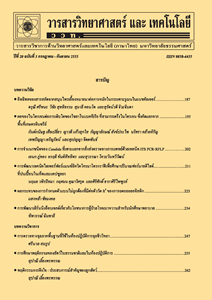การผลิตก๊าซไฮโดรเจนจากกระบวนการเปลี่ยนรูปก๊าซไบโอมีเทนอัดด้วยไอน้ำโดยใช้ตัวเร่งปฏิกิริยาแพลเลเดียมบนตัวรองรับอะลูมินาภายใต้สภาวะอุณหภูมิต่ำ
Main Article Content
Abstract
บทคัดย่อ
งานวิจัยนี้ได้ศึกษาระบบการผลิตก๊าซไฮโดรเจนด้วยกระบวนการเปลี่ยนรูปก๊าซไบโอมีเทนอัดด้วยไอน้ำ (steam reforming process) ภายใต้สภาวะอุณหภูมิต่ำ (400-600 °C) โดยจะแบ่งการดำเนินงานวิจัยออกเป็น 2 ขั้นตอน ขั้นตอนแรก คือ การสร้างระบบการผลิตก๊าซไฮโดรเจนด้วยกระบวนการเปลี่ยนรูปด้วยไอน้ำในระดับ lab scale โดยใช้เครื่องปฏิกรณ์แบบเบดนิ่ง (fixed bed reactor) และขั้นตอนที่สอง คือ การผลิตก๊าซไฮโดรเจนจากก๊าซไบโอมีเทนอัด หรือ CBG (compressed bio-methane gas) ภายใต้สภาวะอุณหภูมิต่ำด้วยระบบการผลิตที่สร้างขึ้นในขั้นแรก ซึ่งก๊าซไบโอมีเทนอัดที่ใช้ในการทดลองมาจากสถาบันวิจัยและพัฒนาพลังงานนครพิงค์ มหาวิทยาลัยเชียงใหม่ และใช้แพลเลเดียมบนตัวรองรับอะลูมินา (Pd/Al2O3) เป็นตัวเร่งปฏิกิริยา ซึ่งศึกษาผลกระทบของอุณหภูมิภายในเครื่องปฏิกรณ์และอัตราการไหลของก๊าซไบโอมีเทนอัดที่ใช้ในการทำปฏิกิริยาที่มีผลต่อปริมาณของก๊าซไฮโดรเจนที่ผลิตได้ โดยอุณหภูมิที่ใช้ในเครื่องปฏิกรณ์อยู่ในช่วง 400-600 °C อัตราการไหลของก๊าซไบโอมีเทนอัดที่ใช้ในการทดลองอยู่ในช่วง 50-300 ml/min และน้ำหนักของตัวเร่งปฏิกิริยา Pd/Al2O3 ที่ใช้เท่ากับ 0.5 กรัม จากการทดลองพบว่าก๊าซไฮโดรเจนสามารถผลิตได้จากกระบวนการเปลี่ยนรูปก๊าซไบโอมีเทนอัดด้วยไอน้ำภายใต้สภาวะอุณหภูมิต่ำ โดยอุณหภูมิและอัตราการไหลของก๊าซไบโอมีเทนอัดที่ใช้ในการทำปฏิกิริยามีผลต่อปริมาณก๊าซไฮโดรเจนที่ผลิตได้ ซึ่งที่อัตราการไหลของก๊าซไบโอมีเทนอัดเท่ากับ 50 ml/min อุณหภูมิภายในเครื่องปฏิกรณ์เท่ากับ 600 °C ให้สัดส่วนโดยโมลของก๊าซไฮโดรเจน (H2) ออกมาเป็นผลิตภัณฑ์สูงที่สุดเท่ากับ 34.74 % โดยคิดเป็นผลได้ร้อยละ (% yield of H2) เท่ากับ 10.72 % ซึ่งถือว่าเป็นสภาวะที่เหมาะสมที่สุดที่ใช้ในการทดลองนี้ และสามารถคำนวณร้อยละการเปลี่ยนไปเป็นผลิตภัณฑ์ของก๊าซมีเทน (% CH4 conversion) ที่สูงที่สุดในการทดลองได้เท่ากับ 58.29 %
คำสำคัญ : ก๊าซไฮโดรเจน; กระบวนการเปลี่ยนรูปด้วยไอน้ำ; ก๊าซไบโอมีเทนอัด; แพลเลเดียม
Abstract
This research aimed to study the production of hydrogen from compressed bio-methane gas by steam reforming process under low temperature condition (400-600 °C). The study can be divided into 2 parts. The first part was creating a system in lab scale to produce hydrogen with a steam reforming process. This system is used fixed bed reactor. The second part was hydrogen production by stream reforming process under low temperature condition from system in first part. The production was used compressed bio-methane gas (CBG) from Energy Research and Development Institute – Nakornping, Chiang Mai University as a feedstock and alumina-supported palladium (Pd/Al2O3) as a catalyst. This will study the effects of temperature inside the reactor and the flow rate of compressed bio-methane gas in the reaction that affects the amount of hydrogen produced. The temperature in the reactor is in the range 400-600 °C, flow rate of compressed bio-methane gas used in experiments in the range 50-300 ml/min and the weight of the Pd/Al2O3 catalyst at 0.5 grams. The results had shown that hydrogen can be produced from compressed bio-methane gas by steam reforming process under low temperature conditions. The temperature inside the reactor and the flow rate of compressed bio-methane gas in the reaction can affect the amount of hydrogen produced. The maximum molar ratio of hydrogen gas at 34.74 % was achieved at compressed bio-methane gas flow rate of 50 ml/min and reactor temperature at 600°C, representing percent yield of H2 (% yield of H2) equal to 10.72 % which is the appropriate condition tests in this experiment. The maximum of the percent conversion of methane (% CH4 conversion) in the experiment were 58.29 %.
Keywords: hydrogen; steam reforming process; compressed bio-methane gas; palladium


